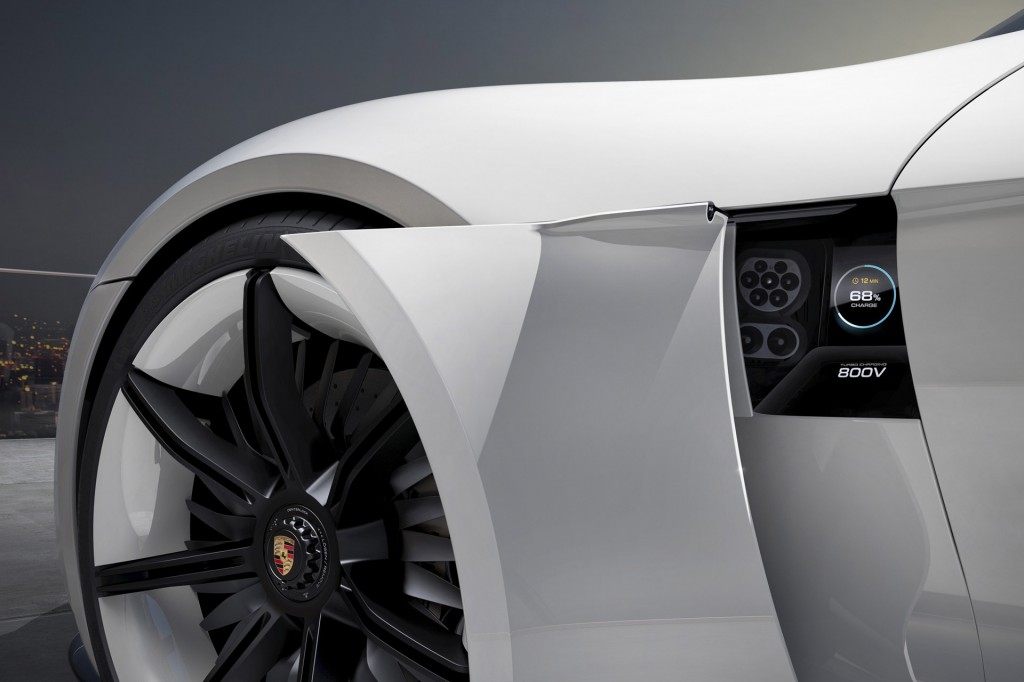The Porsche Taycan—since way back in its early 2015 Mission E Concept days—has been discussed by Porsche in two distinct ways.
On one hand it’s a Tesla rival, capable of meeting higher standards of performance than the Model S or Model 3. And on the other hand it’s at the lead of a big part of Porsche’s future, as it sees all (or nearly all) of its cars eventually becoming electric.
At the center of Porsche’s intent to one-up Tesla—outside of the Nürburgring bragging rights that might not matter to many Tesla fans—has been its 800-volt electrical architecture, and the faster 350-kw CCS-format charging that it allows without added bulk. Porsche Turbo Charging, as it’s been called along the way, allows an 80-percent charge in as little as 15 minutes, and the capability will be included in all Taycan production models.
DON’T MISS: Porsche Mission E to be called Porsche Taycan
Up until now Turbo Charging seemed like a healthy jab at Tesla and its Supercharger network, and a term that would be smart to place all over charging hardware and marketing materials while the advantage is theirs. However, it may never become a true shot at the bow.
Porsche is big on heritage and continuity, and a hint on model positioning for the production 2020 Porsche Taycan suggests that on the way to the future, the sports-car maker may not be willing to give up all of its internal-combustion past—perhaps especially its "Turbo" badge.
It appears the performance version of the Porsche Taycan EV will be branded “Turbo”.
Because ICE nomenclature is how one converts customers to EV.
— Alex Roy (@AlexRoy144) December 26, 2018
In correspondence from a “Porsche Global Brand Ambassador” at the automaker, The Drive’s Alex Roy was informed of initial pricing from the low $90,000 range up to over $130,000 (in line with what has previously been said). But what accompanied that was that there will be three models, Taycan, Taycan 4S, and Taycan Turbo.
Although this is a single correspondence, and the person who wrote the e-mail might have accidentally included Taycan Turbo—a “legacy automaker” stumble like the oil-change notices that were widespread for early Nissan Leaf owners—it’s crafted in a way that doesn’t leave a lot of room for that confusion.
CHECK OUT: Audi e-tron GT electric sports car is its take on Porsche Taycan
Porsche executives have said previously that the Taycan (Mission E) would borrow some pieces of existing Porsche model nomenclature. However, the term Turbo was not one we expected to see. When contacted by our colleagues at Motor Authority, Porsche Cars North America confirmed that no official pricing or information has been announced.

Porsche Mission E concept, 2015 Frankfurt Auto Show
As of earlier in the year, Porsche said that it was still working on how to present its high-power charging technology for North America. With one each at its 189 U.S. dealerships, several at each of its Experience Centers (LA and Atlanta), and a few more 350-kw CCS stations through Electrify America and EVgo, it’s likely that there will be more than 200 stations capable of charging the Taycan at its peak rate around the time the vehicle is launched.
READ MORE: Porsche already has a prototype that will charge faster than its 350-kw Taycan
Porsche currently has a number of models that are turbocharged yet don’t bear the Turbo badge, so it’s already using the badge to denote top-performance versions rather than everything that uses exhaust-fed forced induction.

2010 Porsche 911 Turbo
Porsche Cars North America president and CEO Klaus Zellmer, in an interview with this correspondent earlier this year, said that in the future, being sustainable is going to be an increasingly important part of the brand and gaining acceptance for the brand. In response to a question on how the car will be sold and distinguished in the lineup, he said: “We see a big potential for customers to say, ‘Yes, I want to be part of a movement reducing CO2 emissions’...and if you can combine that with a technology that is worth carrying the Porsche crest, that’s a fantastic combination.”
All that said, calling the halo model of the lineup—perhaps the one that best shows off the performance potential of electric—the Turbo may seem a bit like calling a version with a different battery chemistry the TDI. Some references may just not deserve to be mixed, and sometimes heritage might be best left to become heritage.













